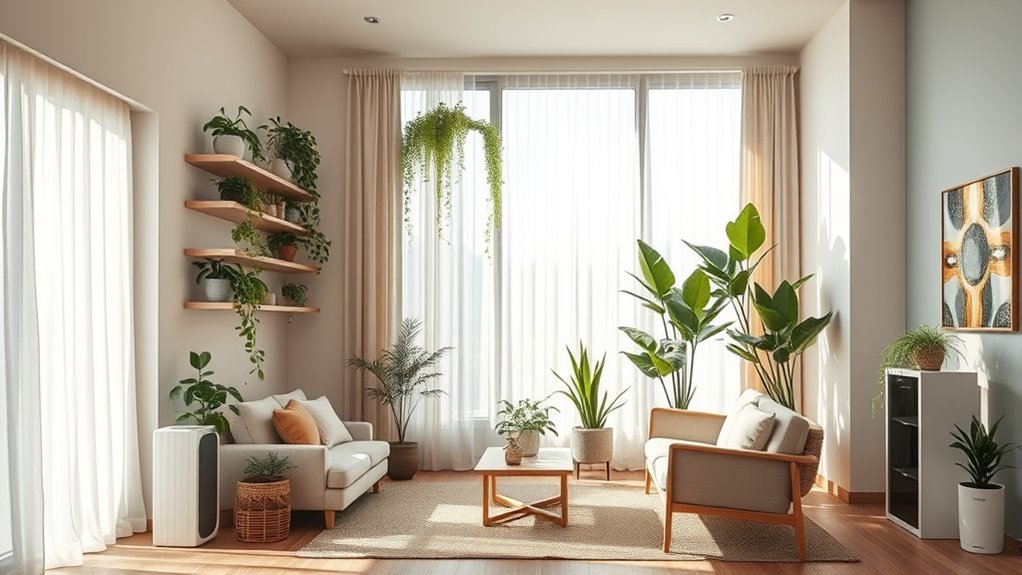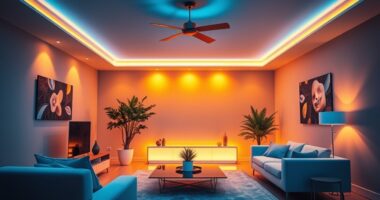To create a healthier living space, focus on improving indoor air quality by opening windows daily, using air purifiers with HEPA filters, and avoiding pollutants like cigarette smoke and harsh cleaners. Maximize natural light with large windows, sheer curtains, and reflective surfaces. Incorporate houseplants to filter toxins and boost humidity. Small adjustments like these can transform your home into a calming sanctuary that supports both your physical and mental well-being—discover more ways to optimize your space below.
Key Takeaways
- Incorporate proper ventilation and air purification to reduce indoor pollutants and improve air quality.
- Maximize natural lighting through strategic window placement and light-colored, reflective surfaces.
- Use houseplants and natural cleaning products to filter toxins and enhance indoor environmental health.
- Arrange furniture to optimize sunlight entry and promote airflow throughout the space.
- Create a calming environment by minimizing artificial lighting and incorporating elements that boost mood and well-being.

Have you ever wondered how your living space can boost your overall well-being? The environment inside your home plays a vital role in your health, influencing everything from your mood to your immune system. Two key elements that profoundly impact your wellness are indoor air quality and natural lighting. Improving these aspects isn’t complicated, and doing so can make a noticeable difference in how you feel every day.
First, focus on enhancing your indoor air quality. Poor air quality can lead to headaches, fatigue, allergies, and even respiratory issues. You can start by ensuring proper ventilation—opening windows regularly to let fresh air circulate is a simple yet effective step. Using exhaust fans in kitchens and bathrooms helps remove moisture and pollutants that can cause mold growth and indoor air pollution. Consider investing in air purifiers equipped with HEPA filters to trap dust, pollen, pet dander, and other airborne irritants. Avoid smoking indoors and minimize the use of harsh chemical cleaners or aerosols, which release volatile organic compounds (VOCs) into the air. Choosing natural cleaning products and houseplants can also improve air quality, as some plants naturally filter toxins and increase humidity levels. Additionally, selecting best restaurants that prioritize quality and ambiance can contribute positively to your overall environment when dining at home or entertaining guests.
Natural lighting is another powerful component of wellness home design. Sunlight has been shown to elevate mood, regulate sleep cycles, and boost vitamin D production. To maximize natural lighting, opt for large windows, skylights, or glass doors that invite sunlight into your living spaces. Keep window treatments light and translucent, so they don’t block the flow of natural light. Arrange your furniture to avoid obstructing windows, allowing sunlight to reach deeper into your home. If certain areas lack sufficient light, consider reflective surfaces or lighter wall colors that bounce sunlight around the room. Besides aesthetics, natural lighting can reduce the need for artificial lighting during the day, which helps you save energy and create a more soothing, inviting atmosphere.
Incorporating these wellness-focused design elements doesn’t mean you have to overhaul your entire home. Small adjustments—like opening windows daily, adding a few houseplants, or swapping heavy curtains for sheer ones—can have a profound impact on your health. When you prioritize indoor air quality and natural lighting, you create a sanctuary that supports your physical and mental well-being. Your home should be a place where you feel energized, relaxed, and healthy, and making these mindful choices helps guarantee it is. Ultimately, a well-designed space isn’t just about aesthetics; it’s about cultivating an environment that nurtures your body and mind every single day.
Frequently Asked Questions
How Can I Improve Indoor Air Quality Effectively?
To improve indoor air quality effectively, you should start by adding indoor plants, which naturally filter pollutants and increase oxygen. Additionally, use air purifiers with HEPA filters to remove dust, allergens, and airborne toxins. Keep your home ventilated by opening windows regularly, and avoid smoking indoors. Combining these strategies helps create a healthier living environment, making your space fresher and safer for everyone.
What Are the Best Natural Lighting Options?
You can enhance natural lighting by considering skylight installation, which floods your space with daylight, making it brighter and more inviting. Additionally, explore window treatment options like sheer curtains or blinds that control light without blocking it entirely, maintaining a natural feel. These choices help you maximize sunlight, boost mood, and reduce energy use, creating a healthier, more vibrant living environment effortlessly.
How Does Color Choice Affect Well-Being?
Imagine you choose calming hues like soft blues or greens in your space; these colors, rooted in color psychology, can substantially boost your well-being. For example, a home office painted in soothing shades reduces stress and enhances focus. Your color choices influence mood and energy levels, so selecting the right hues promotes relaxation and mental clarity, contributing to a healthier, more balanced living environment.
Which Eco-Friendly Materials Promote Health?
When choosing eco-friendly materials, you should look for sustainable flooring options like bamboo or cork, which are renewable and durable. Opt for non-toxic finishes such as low-VOC paints and natural oils to improve indoor air quality. These choices help create a healthier living environment, reduce your carbon footprint, and guarantee that your space is safe and welcoming for everyone. Prioritizing these materials makes a real difference in your home’s overall wellness.
How Can I Reduce Electromagnetic Radiation at Home?
Some believe electromagnetic radiation impacts health, but evidence varies. To reduce EMF exposure, you can apply emf shielding techniques like installing shielding paint or window films, and practice smart meter mitigation by turning off meters or relocating them away from living areas. Keep devices away from your body, use wired connections instead of Wi-Fi, and limit your exposure time. These steps help create a safer, lower-radiation environment at home.
Conclusion
Think of your home as a garden, where each mindful choice helps it flourish. By designing with wellness in mind, you’re planting seeds for a healthier, happier life. When you prioritize natural light, clean air, and calming spaces, you’re nurturing a sanctuary that supports your well-being every day. Remember, your home is your most valuable landscape—tend to it with care, and it’ll bloom with comfort and vigor for years to come.









